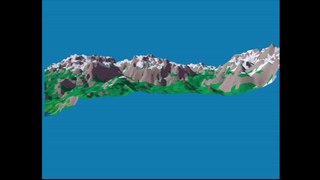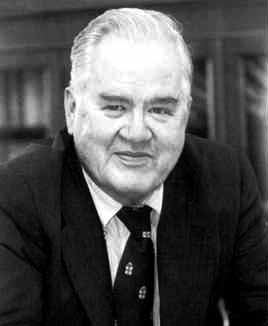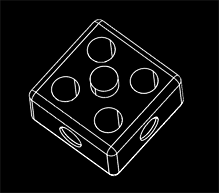
Rendering or image synthesis is the process of generating a photorealistic or non-photorealistic image from a 2D or 3D model by means of a computer program. The resulting image is referred to as the render. Multiple models can be defined in a scene file containing objects in a strictly defined language or data structure. The scene file contains geometry, viewpoint, textures, lighting, and shading information describing the virtual scene. The data contained in the scene file is then passed to a rendering program to be processed and output to a digital image or raster graphics image file. The term "rendering" is analogous to the concept of an artist's impression of a scene. The term "rendering" is also used to describe the process of calculating effects in a video editing program to produce the final video output.

In 3D computer graphics, radiosity is an application of the finite element method to solving the rendering equation for scenes with surfaces that reflect light diffusely. Unlike rendering methods that use Monte Carlo algorithms, which handle all types of light paths, typical radiosity only account for paths which leave a light source and are reflected diffusely some number of times before hitting the eye. Radiosity is a global illumination algorithm in the sense that the illumination arriving on a surface comes not just directly from the light sources, but also from other surfaces reflecting light. Radiosity is viewpoint independent, which increases the calculations involved, but makes them useful for all viewpoints.

The painter's algorithm is an algorithm for visible surface determination in 3D computer graphics that works on a polygon-by-polygon basis rather than a pixel-by-pixel, row by row, or area by area basis of other Hidden-Surface Removal algorithms. The painter's algorithm creates images by sorting the polygons within the image by their depth and placing each polygon in order from the farthest to the closest object.

In computer graphics, rasterisation or rasterization is the task of taking an image described in a vector graphics format (shapes) and converting it into a raster image. The rasterized image may then be displayed on a computer display, video display or printer, or stored in a bitmap file format. Rasterization may refer to the technique of drawing 3D models, or to the conversion of 2D rendering primitives, such as polygons and line segments, into a rasterized format.
Computational geometry is a branch of computer science devoted to the study of algorithms which can be stated in terms of geometry. Some purely geometrical problems arise out of the study of computational geometric algorithms, and such problems are also considered to be part of computational geometry. While modern computational geometry is a recent development, it is one of the oldest fields of computing with a history stretching back to antiquity.

John Edward Warnock was an American computer scientist, inventor, technology businessman, and philanthropist best known for co-founding Adobe Systems Inc., the graphics and publishing software company, with Charles Geschke in 1982. Warnock was President of Adobe for his first two years and chairman and CEO for his remaining sixteen years at the company. Although he retired as CEO in 2001, he continued to co-chair the Adobe Board of Directors with Geschke until 2017. Warnock pioneered the development of graphics, publishing, web and electronic document technologies that have revolutionized the field of publishing and visual communications.

A graphics processing unit (GPU) is a specialized electronic circuit initially designed to accelerate computer graphics and image processing. After their initial design, GPUs were found to be useful for non-graphic calculations involving embarrassingly parallel problems due to their parallel structure. Other non-graphical uses include the training of neural networks and cryptocurrency mining.

John Wilder Tukey was an American mathematician and statistician, best known for the development of the fast Fourier Transform (FFT) algorithm and box plot. The Tukey range test, the Tukey lambda distribution, the Tukey test of additivity, and the Teichmüller–Tukey lemma all bear his name. He is also credited with coining the term bit and the first published use of the word software.

In 3D computer graphics, hidden-surface determination is the process of identifying what surfaces and parts of surfaces can be seen from a particular viewing angle. A hidden-surface determination algorithm is a solution to the visibility problem, which was one of the first major problems in the field of 3D computer graphics. The process of hidden-surface determination is sometimes called hiding, and such an algorithm is sometimes called a hider. When referring to line rendering it is known as hidden-line removal. Hidden-surface determination is necessary to render a scene correctly, so that one may not view features hidden behind the model itself, allowing only the naturally viewable portion of the graphic to be visible.

In computational geometry, the point-in-polygon (PIP) problem asks whether a given point in the plane lies inside, outside, or on the boundary of a polygon. It is a special case of point location problems and finds applications in areas that deal with processing geometrical data, such as computer graphics, computer vision, geographic information systems (GIS), motion planning, and computer-aided design (CAD).

Ralph William Gosper Jr., known as Bill Gosper, is an American mathematician and programmer. Along with Richard Greenblatt, he may be considered to have founded the hacker community, and he holds a place of pride in the Lisp community. The Gosper curve and the Gosper's algorithm are named after him.

In 3D computer graphics, solid objects are usually modeled by polyhedra. A face of a polyhedron is a planar polygon bounded by straight line segments, called edges. Curved surfaces are usually approximated by a polygon mesh. Computer programs for line drawings of opaque objects must be able to decide which edges or which parts of the edges are hidden by an object itself or by other objects, so that those edges can be clipped during rendering. This problem is known as hidden-line removal.
Martin Edward Newell is a British-born computer scientist specializing in computer graphics who is perhaps best known as the creator of the Utah teapot computer model.

Mesh generation is the practice of creating a mesh, a subdivision of a continuous geometric space into discrete geometric and topological cells. Often these cells form a simplicial complex. Usually the cells partition the geometric input domain. Mesh cells are used as discrete local approximations of the larger domain. Meshes are created by computer algorithms, often with human guidance through a GUI, depending on the complexity of the domain and the type of mesh desired. A typical goal is to create a mesh that accurately captures the input domain geometry, with high-quality (well-shaped) cells, and without so many cells as to make subsequent calculations intractable. The mesh should also be fine in areas that are important for the subsequent calculations.
In geometry, visibility is a mathematical abstraction of the real-life notion of visibility.

Boolean operations on polygons are a set of Boolean operations operating on one or more sets of polygons in computer graphics. These sets of operations are widely used in computer graphics, CAD, and in EDA.
Ruth A. Weiss is a British-American software engineer known for her work in computer graphics, especially the hidden-line removal problem. She also developed, together with Richard Hamming, the L2 programming language, a floating-point mathematical package for the IBM 650.













